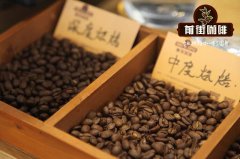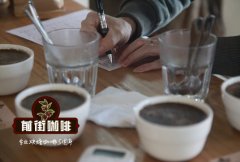How to tell if defective beans in coffee affect coffee flavor

Professional coffee knowledge exchange more coffee bean information please follow the coffee workshop (Wechat official account cafe_style)
Defective beans refer to abnormally developed beans or beans that are contaminated in the refining process. If defective beans are mixed with raw beans, the aroma of coffee will be affected, and the brewing quality will be lower than that of coffee without defective beans. After picking the coffee, the farmers usually put the coffee cherries in the sink and pick out the immature fruit. When coffee enters the Dry Mill process, a specific gravity sorter will also be used to pick out immature beans, and then an electric screening machine will be used to pick out foreign bodies and defective beans. Finally, there is a manual picking procedure to ensure that no defective beans are mixed.
Defective beans of boutique coffee
Fine coffee is usually not mixed with any defective beans. On the other hand, once defective beans such as black beans or fermented beans are imported, the raw beans cannot be recognized as fine coffee. Although some small shops still pick defective beans by hand, there is no need to pick them again if they have been strictly screened for fine coffee. Quaker (immature or dead beans) must be picked out after baking. Brazilian coffee will produce astringency and bad smell as long as it is mixed with a Quaker, while coffee from Colombia and Central America will not smell as a result of mixing with Quaker, but it will still affect the aroma of the coffee. However, there are few cases of defective beans such as Quaker in boutique coffee.
The source of odor of raw beans
Most coffee beans will smell as a result of being mixed with defective beans. The following is a more common description of the smell.
1. Chemical odor
Including the smell of medicine and chlorine and other odors. Usually affected by unconfirmed dryness, Rain Water, moisture and other factors, it is the smell of raw beans caused by bacterial infection and mildew.
two。 Musty taste
If raw beans are stored in a humid environment, the fat in the coffee beans will absorb the smell of the environment. This kind of beans usually produce the stench of cheese, and the coffee brewed is cloudy.
3. Earthy taste
The peculiar smell produced by the contamination of the soil and the absorption of organic matter from the soil in the process of fruit harvesting or drying. The coffee extracted from this kind of beans is cloudy, and the final rhyme also has an earthy flavor.
4. Fermented taste
When the fruit is removed later in the washing refining process, or the raw beans soaked in the sink for too long, it will produce the bad smell of fermentation. In addition, fruits that are overripe and fall early will ferment themselves in the process of natural drying and produce a similar smell.
5. Overripe taste
Overripe fruit will make raw beans smell bad. Although these beans do not have a strong fermented smell, they produce a stronger flesh smell over time.
6. Immature taste
If the coffee beans are mixed with immature raw beans, the coffee will become cloudy and astringent. Natural dried raw beans commonly found in Brazil, as well as water-washed coffee beans that have been carefully selected.
7. Potato flavor
If the worm only gets into the coffee fruit, it will make the raw bean smell like a steamed potato. Coffee beans commonly found in Rwanda and most East African countries.
END
Important Notice :
前街咖啡 FrontStreet Coffee has moved to new addredd:
FrontStreet Coffee Address: 315,Donghua East Road,GuangZhou
Tel:020 38364473
- Prev

What is the taste of coffee? the taste spectrum of coffee is determined by the degree of baking.
Professional coffee knowledge exchange more coffee bean information Please pay attention to the coffee workshop (Wechat official account cafe_style) Coffee taste spectrum consists of smell spectrum and taste spectrum, the former directs dry and wet aroma, while the latter refers to water-soluble taste. The aroma of the flavor spectrum is appreciated by the sense of smell before and after the nose, and the liquefaction taste of the taste spectrum is captured by the sense of taste. The smell and taste of coffee often depend on the variety,
- Next

What is the Mokhtar mode of Yemeni coffee flavor in the ancient city of Sanaa, Yemen? Characteristics of Yemeni coffee
Professional coffee knowledge exchange more coffee bean information please follow coffee workshop (Wechat official account cafe_style) Yemen is the first country to use coffee as a cash crop, legend has it that Muslim Sufi pilgrims were introduced from Ethiopia in the 6th century, the most correct spelling should be Al-Mahka, which is spelled in Arabic, growing on steep terrain with little rainfall and poor land ridges.
Related
- Detailed explanation of Jadeite planting Land in Panamanian Jadeite Manor introduction to the grading system of Jadeite competitive bidding, Red bid, Green bid and Rose Summer
- Story of Coffee planting in Brenka region of Costa Rica Stonehenge Manor anaerobic heavy honey treatment of flavor mouth
- What's on the barrel of Blue Mountain Coffee beans?
- Can American coffee also pull flowers? How to use hot American style to pull out a good-looking pattern?
- Can you make a cold extract with coffee beans? What is the right proportion for cold-extracted coffee formula?
- Indonesian PWN Gold Mandrine Coffee Origin Features Flavor How to Chong? Mandolin coffee is American.
- A brief introduction to the flavor characteristics of Brazilian yellow bourbon coffee beans
- What is the effect of different water quality on the flavor of cold-extracted coffee? What kind of water is best for brewing coffee?
- Why do you think of Rose Summer whenever you mention Panamanian coffee?
- Introduction to the characteristics of authentic blue mountain coffee bean producing areas? What is the CIB Coffee Authority in Jamaica?

